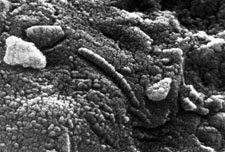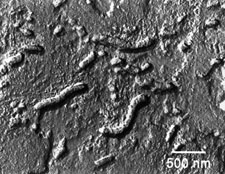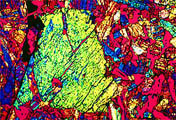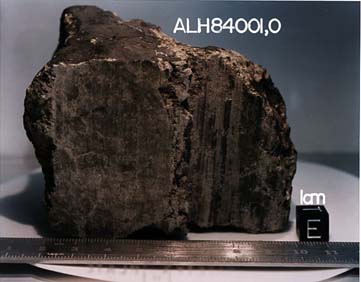




Searching
for Life on Mars
The Martian Meteorites
The
Viking
spacecraft were not designed to look for evidence of fossilized
life on Mars. But the opportunity to examine such evidence
has been available for nearly a century. In 1911 a meteorite
landed in Egypt and reportedly killed a dog. This is the famous
meteorite that fell in the village of Nakhla.
 A section through a fragment of the Nakhla Meteorite, courtesy of the Natural History Museum, UK. © John Hodges, 1999 The Nakhla meteorite originated on Mars, though this was not recognized until the mid nineteen-eighties. The unusual chemical composition of this and two other similar meteorites, from Shergotty in India and Chassigny in France, were known about. They contain some volatile chemicals and some unusual isotopes of oxygen. But no-one had thought of a Martian origin. Work in the 1980's showed that they were young - around 130 to 180 million years old (compared to 5.5 billion years old for most rocky meteorites) - and they were apparently igneous - formed from volcanic lava. Eventually researchers discovered tiny traces of Martian atmosphere in the rocks and this determined their true origin. This is not by any means unlikely; Mars is covered with meteorite impact craters some of which are of enormous size - hundreds of kilometers or miles in diameter. Many impacts, even small ones, are so severe that rocky material from the planet can be sprayed into space to become interplanetary meteorites themselves. |
|
Martian meteorite. Click on image to see more microscopic views © 1995-2000 by Michael W. Davidson and The Florida State University. Earth is the largest of the inner planets and, when the additional mass of the Moon is added, it forms the largest local gravitational attractor in the vicinity of Mars. It is inevitable that some matter ejected from Mars will find its way to Earth. Earth, though a small target compared with the volume of local space, is like a gravitational vacuum cleaner that pulls orbiting objects towards it. What is more, because the matter is orbiting there is plenty of time and many opportunities for some matter to be inexorably drawn towards Earth. Eventually some of the ejected debris of Martian impacts will land on Earth as meteorites. It has been estimated by Bret Gladman's team of researchers, at Cornell University, that as much as 7.5% of the material thrown off Mars reaches Earth; and 2.5% does so in under ten million years which is within the dormant lifespan of some known microbes. If microscopic rock-living life-forms similar to those found on Earth also existed on Mars, then it is virtually certain that Martian microbes will have reached Earth. |
|
| The same is true the other way: Meteorite impacts on Earth could achieve the same result, though the amount of material transferred will be considerably smaller. The Earth's gravitational effects tend to prevent the escape of material, both from the surface and from the the Earth's locality in space. However, it is quite possible that Earth rocks containing microbes have traveled to other planets and moons in the Solar System. Should we discover life on other Solar System bodies, and find it has similarities to that on Earth, we may never be able to untangle its true origin. |
|
It
is argued by some experts that in the early Solar System it would
have been much easier for life to evolve on Mars than it would have
been on Earth. Earth underwent a cataclysmic event when
the Moon was formed and this would have extinguished any form of
evolving life. It was also bigger and therefore hotter
and less hospitable than Mars for the survival of life - more like
Venus is today. Earth is a bigger target for interstellar
debris than Mars. Impacts are also faster and more devastating,
because the gravitational acceleration is higher. Overall,
Mars would offer better conditions for budding life at that time
than would Earth.  (Above) Pancake volcanoes on Venus. The early Earth may have been just as inhospitable to life |
|
|
Once it was established that Martian meteorites could be found, scientists started to look for them. One place where meteorites in general are relatively easily found is Antarctica and many have been collected in recent years from this continent, including some from Mars. In 1989 three British researchers from the Open University and the Natural History Museum (Collin Pillinger, Ian Wright and Monica Grady) published a paper on meteorite EETA79001, which had been found in Antarctica. It was certainly of Martian origin, but it contained a surprise. There were organic compounds present, which the team claimed would have been associated with living organisms on Earth. The publication went unnoticed by the majority of researchers and the public at the time. In 1996 though, NASA researchers held a press conference that attracted front page headlines across the world. They announced that they had discovered fossilized life in a Martian meteorite.
The meteorite had been discovered by NASA scientists in the Antarctic in 1984. This meteorite, numbered ALH 84001, was found to have originated on Mars. Most meteorites made of rock are found to be more than 4.5 billion years old, having solidified from molten material before the the Solar System itself formed. ALH 84001 was different. It was ejected into space some 16 million years ago and contained microscopic cavities filled with gas identical to the atmosphere of Mars, that were the tell-tale signs of its origin. The NASA team working on the meteorite put forward reasoned arguments. It was estimated that the life-form in meteorite ALH 84001 entered the original rock about 3.6 billion years ago. After being blasted off Mars by an impacting meteorite and traveling for 16 million years ago through space, it landed in the Antarctic just 20 thousand years ago. The main evidence for life came from the discovery of Polycyclic Aromatic Hydrocarbons (PAH) molecules within the rock. These were more concentrated near the center and this suggested that Earthly contamination was unlikely. PAH molecules are organics associated with life processes. |

Minute caterpillar-like structures were found deep inside the meteorite. It was claimed these were fossil bacteria, for they looked similar to some found on Earth. However, it was about one-hundredth the size of an Earth bacteria and other scientists argued that it was simply too small and was just part of the minerals in the rock. So that seemed an end to the initial euphoria, but then other teams of biologists came up with an astounding discovery. Super-minute bacteria, of the type found in the meteorite, do exist on Earth. They are now known as nano-bacteria. So the debate swung back in favor of the life protagonists. |
.
The
antagonists then came back with a highly critical report on the way
the initial tests had been carried out and alleged that the
sample had been contaminated on Earth, probably while it lay in the
ice for 20,000 years. This is how the argument now stands, though
one has to wonder how the bacteria got so far inside the meteorite
and then became fossilized, in such adverse environmental conditions
and such a relatively short time. |
The Pathfinder lander, which arrived on Mars in 1997, was not actually looking for life. It has really raised more questions about the life debate, by suggesting from the rock spectral analysis that andesitic rocks exist on Mars (ie rock created at a subduction zone like the Andes). While this does not demonstrate the existence of life directly, it does imply that liquid water existed for some considerable time on the surface and this is a pre-requisite for carbon-based life. |
|
Other photographic evidence from Viking and the more recent Global Surveyor, strongly suggest the existence of oceanic shore lines in some parts, notably in the low-lying bottom of the Valles Marineris - the great canyon that runs across nearly a quarter of the planet. Again this is circumstantial support for the possibility of life. NASA, the European Space Agency, or NASDA of Japan will almost certainly put a lander into the valley within the next few years. The results will be interesting to see.
The primary argument against carbon-based life currently being active on Mars, or active in the past for any length of time, comes from the fact that the atmosphere is largely carbon-dioxide. Almost the first thing that developing living organisms do in the presence of CO2 is use it! Had life existed in any abundance, then the CO2 would have been converted into something else - limestone perhaps. Although limestone has been detected it is thought to be oolitic - precipitated from water and not from living matter. The argument does not hold together entirely, though. There are forms of simple, anaerobic life that make no use of carbon-dioxide, and in fact the nano-bacteria postulated for Mars are very much of this nature. Even if Mars supports no life now, it may have done so at one time. Studies suggest that the early Martian environment may have been similar to that of the early Earth. Both planets show histories of liquid surface water, warmer temperatures, and cometary and meteoritic impacts, as well as relatively thick carbon-dioxide and nitrogen atmospheres and volcanic activity. The elements needed for chemical evolution may have been present on Mars, even if other factors were unfavorable to the continuing evolution of life. Because of Earth's geologic activity, unaltered rocks dating back to 3.5 billion years are rare, but on Mars over half the planet dates to about 3.8 billion years ago. So, studying Mars helps us understand events that occurred while life on Earth was just beginning and it allows us to investigate the possibility of extinct Martian life. Recent evidence of ancient microbial life on Mars has renewed intense interest in the planet. A number of missions planned for the next decade will help satisfy that curiosity. © All images NASA, unless otherwise shown |
![]()
Are
We All From Mars?
Did
Mars Seed Earth?
New
Life for the 'Mars Rock'
Science
Explained - the Martian fossils
Search
for life on Mars will start in Siberia
Life on
Mars I
Life on Mars
II
Return
to Mars - Children's page
Go
to
Home
| Space Station
| Mars | Rainforest
© 1999 Satellite Events Enterprises Inc.


